Аннотация
В статье раскрываются характеристики и особенности транслирования протестных повесток в социальных сетях, приводится теоретическое обоснование значимости социальных сетей в жизни современного общества, реализации гражданской, протестной активности. Для определения характеристик трансформации повесток протеста как одного из механизмов демобилизации движений было проведено исследование с использованием политологического инструментария, в частности, методов: event-анализ, контент-анализ, case-study, сравнительного анализа. Авторами выбрано 7 наиболее крупных и известных кейсов протестов, реализованных на территории России в период с 2017 по 2021 г., и ряд протестных сообществ в социальной сети «ВКонтакте» и мессенджере «Телеграмм» по соответствующим кейсам. В ходе сбора и анализа данных в сообществах были произведены количественные подсчеты основных характеристик в социальных сетях: общее количество постов в рассматриваемой группе, количество постов по основной и каждой дополнительной повестке, а также количество информационных, мобилизационных и отчетных постов. В статье представлена уникальная классификация способов формулирования протестных повесток. Выделены два основных типа повесток: абстрактные и конкретные. На основе подсчетов и экспертного опроса создан коэффициент абстрактности, отражающий динамику размещения постов и трансформацию конкретных публикаций в абстрактные. По итогу были сформулированы основные тезисы и закономерности, применимые для последующего исследования протестных сообществ.
Ключевые слова
Информация о финансировании
Исследование выполнено при финансовой поддержке РФФИ и ЭИСИ в рамках научного проекта № 20-011-31346 «Специфика формирования и динамика трансформации повесток сетевых протестных сообществах в современной России».
Библиографические ссылки
Abramov, R. N. (2006). Mobil’nyy kommunikatsionnyye tekhnologii i povsednevnost’ Reygol’d G. Umnaya tolpa: novaya sotsial’naya revolyutsiya. M.: Fair-press, 2006–416 s. [Mobile Communicative Technology and Everyday Life: Howard Jieingold’s “Smart Mobs”]. Zhurnal sotsiologii i sotsial’noy antropologii [The Journal of Sociology and Social Anthropology], 9(4), 185–192.
Artamonova, Yu. D., Demchuk, A. L. (2020). Konnektivnaya identichnost’ v sovremennom mire [“Connective Identity” In the Contemporary World]. Voprosy filosofii [Voprosy Filosofii], 4, 69–79.
Dawson A., Innes, M. (2019). How Russia’s Internet Research Agency Built its Disinformation Campaign. The Political Quarterly, 90(2), 245–256.
Harrison, T., Dumas, C., DePaula, N. et al. (2017). E-petitioning and Online Media: The Case of #BringBackOurGirls. In Proceedings of the 18th International Conference of the Digital Government Society (pp. 11–20). NY: Staten Island.
Heiss, R., Schmuck, D. & Matthes, J. (2019). What Drives Interaction in Political Actors’ Facebook Posts? Profile and Content Predictors of User Engagement and Political Actors’ Reactions. Information, Communication & Society, 22(10), 1497–1513.
Kastel’s, M. (2016). Vlast’ kommunikatsii [Communication Power]. Moskva: Izd. Dom Vysshey shkoly ekonomiki.
Keane, Dzh. (2015). Demokratiya i dekadans media [Democracy and Media Decadence]. M.: Izd. dom Vysshey shkoly ekonomiki.
Korshunov, I. L. (2019). Regulirovaniye v Internete: zashchita lichnosti ili ogranicheniye svobody [Regulation on The Internet: Protection of The Personality or Limitation of Freedom]. Izvestiya SPbGU [Izvestiya SPbGU], 4(118), 119–125.
Laklau, E. O. (2009). O populizme [On Populist Reason]. Vestnik Moskovskogo universiteta. Ser. 12. Politicheskiye nauki [Moscow University Bulletin. Series 12. Political Science], 3, 54–68.
Maykl, B., Hartvell, K., Nureyev, B. “Myagkaya sila” — palka o dvuh kontsah? [Is Soft Power a Double-Edged Sword?]. Retrieved from https://bricsmagazine.com/ru/articles/myagkaya-sila-palka-o-dvuh-kontsah/.
Savenkov, R. V., Shcheglova, D. V. (2018). Teorii kollektivnogo povedeniya i mobilizatsii resursov: razvitiye kontseptsiy analiza politicheskogo protesta [Theories of Collective Behavior and Resource Mobilization: Elaboration on the Concept of Political Protest]. Vestnik RUDN. Seriya: Politologiya [RUDN Journal of Political Science], 4, 555–563.
Sokolov, A. V., Palagicheva, A. V. (2020). Mobilizatsiya i demobilizatsiya v setevom politicheskom proteste [Mobilization and Demobilization in a Network Political Protest]. Politicheskaya nauka [Political Science], 3, 266–297.
Volodenkov, S. V., Romashkina A. B. (2020). Tekhnologii Internet-kommunikatsii kak instrument vliyaniya na funktsionirovaniye sovremennyh institutov vlasti: aktual’nyye vyzovy [Internet Communication Technologies as a Tool of Affecting Modern Governmental Institutions: Current Challenges]. Vestnik Moskovskogo gosudarstvennogo oblastnogo universiteta. Seriya: Istoriya i politicheskiye nauki [Bulletin of The Msru. Series: History and Political Sciences], 1, 33–40.


